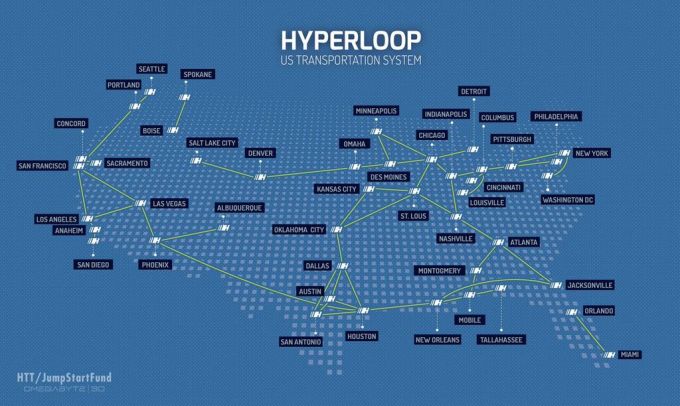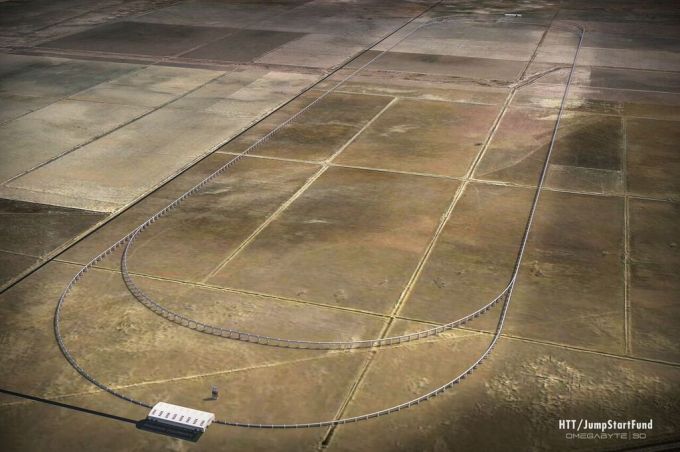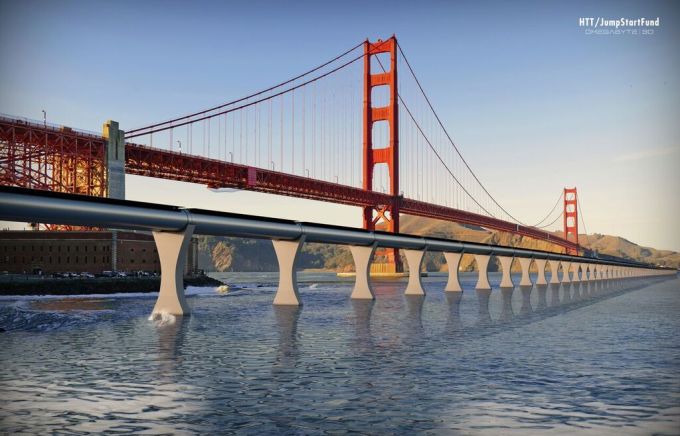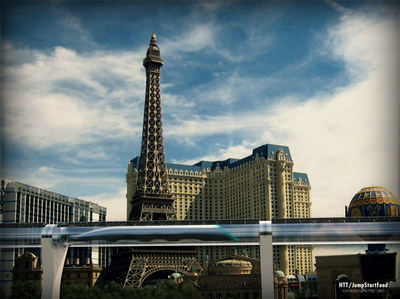HTT PRESS KIT


)


.jpg)




If zipping around in a small pod through a confined tube at around 760 miles per hour sounds a bit claustrophobic, one hyperloop company is hoping it has a remedy.
Hyperloop Transportation Technologies said Sunday it is working on "augmented windows," so passengers in the futuristic high-speed transportation system have something to look at while traveling.
The hyperloop, for the uninitiated, is billionaire Elon Musk's vision for the future of travel. It involves pods hovering on a cushion of air moving through a narrow tube at the speed of sound. Musk unveiled the plans in 2013, but the CEO of Tesla and rocket company SpaceX said he couldn't build it because he did not have the time. The hope for the hyperloop is that it could revolutionize transportation by cutting down travel time and reducing traffic.
But tubular travel doesn't leave much room for many other things people are used to when traveling, like windows. So HTT said it's developing interactive screens you can control with your phone that would let passengers see a realistic landscape outside. The company said it would do that by using motion-capture technology but didn't elaborate further. The "windows" would let you do things like pull up the time, speed you're going, or a map. The company said it is also working on a way for people to be able to see the same things on a screen at the same time.

The idea is to create an experience that's vastly better than what passengers are used to, but not too foreign.
"That's what we're working on besides moving a capsule through a tube," Dirk Ahlborn, chief executive of HTT, said at the South by Southwest tech, music and film festival in Austin, Texas. "Our goal is to make travel suck less."
The company is working with a German augmented reality company called Re'flekt to develop the windows.
HTT is working on a hyperloop track in Quay Valley, California, about halfway between San Francisco and Los Angeles. The company hopes to have the project up and running there in three years. And last week, HTT announced plans to build a track in Europe connecting Slovakia, Austria and Hungary, with the first section to be completed by 2020.
, March 11, 2016 /PRNewswire/ -- Slovakian government officials met with JumpStartFund's Hyperloop Transportation Technologies, Inc. (HTT) this week to finalize and sign an agreement to explore building a local Hyperloop system, with the vision of creating future routes connecting with and .
Photo - http://photos.prnewswire.com/prnh/20160311/343249
" is a technological leader in the automotive, material science, and energy industries, many of the areas that are integral to the Hyperloop system," said Dirk Ahlborn , HTT CEO. "Having a European Hyperloop presence will incentivize collaboration and innovation within and throughout . With our project in Quay Valley, this agreement with , and future developments with other regions of the world, HTT truly has become a global movement."
"Hyperloop in would cut distances substantially and network cities in unprecedented ways. A transportation system of this kind would redefine the concept of commuting and boost cross-border cooperation in ," said Vazil Hudak, Minister of Economy of the Slovak Republic. "The expansion of Hyperloop will lead to an increased demand for the creation of new innovation hubs, in and all over ."
A -to- route could take about 8 minutes at Hyperloop's full speed; a -to- route just 10 minutes. A route between and Košice-a distance of 400 kilometers (250 miles)-could also be considered and would connect the eastern and western sides of with a short trip of only 25 minutes, reducing the typical 4.5 hour car ride dramatically.
"In 1896 the first electric underground railway system was built in and already in 1914 the first electric trainline between and was created," said Bibop Gresta, HTT COO. " continues to confirm its position as one of the most forward thinking countries by embracing innovations like the Hyperloop transportation system."
HTT videos and photos can be found here.
About Hyperloop Transportation Technologies, Inc.Founded in 2013 by JumpStarter Inc. utilizing JumpStarter's crowdfunding and crowd collaboration platform JumpStartFund, Hyperloop Transportation Technologies, Inc. (HTT) designs, manufactures and builds the most highly profitable, fastest, safest, environmentally friendly transportation system for passengers and goods. HTT leverages technology and a team of more than 500 global experts to bring disruptive innovation to the traditional transportation industry. Hyperloop first gained public interest when entrepreneur published a detailed white paper describing a futuristic mode of transport that would move people from to in about 30 minutes. Musk handed the concept to the public asking for entrepreneurs to take over its development while he focused on his existing projects. Hyperloop Transportation Technologies rose to the challenge.
Hyperloop is a tube-based transportation system for inter- and intra-city transport. The removal of air in a tube allows for the passage of capsules at high speeds. The system maintains passenger comfort whilst accelerating capsules safely to 760 mph. Its maximum acceleration is approximately 1g and the experience is similar to a performance car. Hyperloop uses a combination of alternative energy and conservation techniques such as photovoltaics, wind, kinetic, regenerative braking, and geothermal power to ensure sustainability and low cost. This suite of energy sources combined with an accelerated, low-cost build, enables Hyperloop to develop rapidly and generate sustainable profitability, unlike most other transportation modalities.
Hyperloop Transportation Technologies, Inc.
Ministry of Economy of the Slovak Republic
Zuzana Nehajova, Director General at the Directorate General for Innovation and Business Environment
Email
To view the original version on PR Newswire, visit: http://www.prnewswire.com/news-releases/hyperloop-transportation-technologies-reaches-agreement-with-slovakia-300234762.html
SOURCE Hyperloop Transportation Technologies Inc
Related Links


Plans to construct the beginnings of Elon Musk's Hyperloop are now underway in Quay Valley, California. Hyperloop Transportation Technologies (HTT) announced plans for a 5-mile test track late last year and is about to break ground on an initial framework for what HTT CEO Dirk Ahlborn hopes will become the U.S. transportation infrastructure of the future.
Musk first proposed the Hyperloop, a vacuum tube intended to speedily shoot passengers at 800 mph from city to city, in 2013. The idea was to create a mechanism of transportation that could get folks from San Francisco to Los Angeles in under 30 minutes.
But Musk is a busy man, managing both Tesla and SpaceX, and left building plans up to others.
HTT is one of two startups to take on the task since then. Ahlborn assembled a team of volunteer engineers and scientists shortly after Musk put forth the idea, offering equity in the company instead of pay to those willing to put in at least 10 hours of work each week.
The project soon attracted talented individuals from companies like NASA, Boeing, SpaceX and Tesla - and a lot of interest from outside investors as well. According to Ahlborn, more than 600 investors have approached the currently self-funded operation, hoping to get in on the ground floor.
"We think of this as more than a company, it's a movement," Ahlborn told TechCrunch over the phone from JumpStartFund headquarters - a crowdsource funding platform he also runs out of L.A.

The company aims to create a system traveling faster than the speed of sound at a potential 760 mph, and a lower construction cost than "any existing, and yet proposed railway projects," according to the website.
Compare that to a similar plan in California to build a high-speed rail system going (tops) 220 mph and initially costing $6.6 billion and upwards to $33 billion over time to go 400 miles - $82.5 million per mile. It's about $20 million per mile to build HTT's version of the Hyperloop, according to Ahlborn - a fraction of the current cost of building high-speed rail in the U.S.
Though the initial construction is referred to as a test track, Ahlborn told TechCrunch this was actually the beginning of what will eventually become ground zero of a much larger system.
HTT bought land last year to begin initial construction on the Hyperloop in Quay Valley - a proposed 75,000 resident, solar-powered concept city being built in King's County, California that intends to use HTT's test track as its main transportation system.

HTT shared some renderings with us to show what this system will look like in Quay. Construction on the test track begins this year, with analysis of the speed and optimizing the route happening in 2017. Actual passengers should be able to hop on board by 2018 if all goes according to plan.
Quay is halfway between San Francisco and Los Angeles and the beginnings of what Ahlborn envisions for the future of high-speed transport in the U.S. The HTT CEO would like to eventually expand his hyperloop to go from San Francisco to Los Angeles and said he's been speaking with many rail and bus companies as well as government officials to make that happen.
But for now, Ahlborn and his team is focused on building about five miles of test track in a little, futuristic town in the middle of California farm country. Just how quickly will this initial Hyperloop be able to whiz town folks about the length of Quay? A mere 80 seconds, he tells me.
Quay also gives HTT a chance to experiment with newer digital tools Ahlborn believes should be a part of modern transportation. HTT will eliminate coal age relics such as ticketing and include augmented windows and WiFi within its new structure.
Ahlborn mentioned working with a European AR company to help implement some possible Hollywood experiences into the ride as well.
"Being in L.A. and being in Hollywood we think there's maybe some movie experience on the screens," Ahlborn explained. "Rather than a trailer, it's like you are going through Jurassic World and look outside and you see dinosaurs outside. You would have the screens all over the capsule so everybody has kind of the same experience."
Built-in AR screens could also help HTT monetize in other ways - with digital advertising to a captive audience for short bursts as passengers zip from city to city.
HTT isn't the only company laying down tracks. Elon Musk built a test track of his own at SpaceX, allowing students to offer up improvements and play with the plans. The other startup working on the Hyperloop, aptly called Hyperloop Technologies, is laying out its own track in the California desert.

It's early days for all parties and each one still needs to address questions like how this type of rapid acceleration might affect the human body, how to prevent passengers from getting trapped in capsules inside the system, deceleration techniques, and how to manage traffic.
The Hyperloop could change the way we travel or even commute to work on a daily basis. In the future, some of us might even find ourselves working in SF, but commuting from a much more affordable area far away from Silicon Valley's outrageous rental environment.
Of course, the biggest question will be how to win over city and county governments to allow further construction of such a structure and which startup will prevail in the bid to build our human vacuum tube of the future.
Interview With Bibop Gresta At The World Economic Forum


